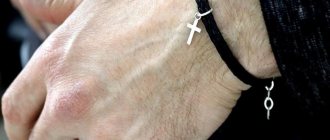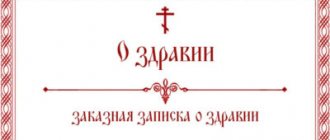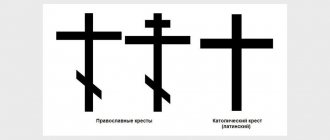Nowadays, on the streets of cities you can often meet people with tattoos on their bodies. In some musical subcultures they have gained popularity comparable to the fashion for rock bands themselves, clothes and hairstyles. Tattoos are becoming common among ordinary people. In the summer it is not difficult to meet girls with tattoos on their sacrum or ankles. How to feel about this, is it good or bad, can a person with tattoos be a Christian? Priest John Kurbatsky (ROC, Kaluga) discusses this phenomenon
***
"Fashionable" fad
Every year, especially in the summer, we notice how many people, especially young people, have fashionable “accessories” in the form of tattoos on their bodies. The number of tattoo parlors in cities is becoming comparable to the number of cafes. People give each other certificates to visit these salons. The majority of visitors there are, of course, young people. If tattoos used to be an element of the prison or, less commonly, army subculture, today it has become a fashionable and common occurrence. It happens that parents themselves bring their teenagers to tattoo parlors. Although in general it is difficult to imagine parents who want to “decorate” their children in this way. In Spain, I remember the advertising stand of a tattoo parlor. A baby is depicted in a diaper, painted from head to toe. And at the top there is the inscription: “Mom, I’m sorry!” The older generation looks at the growing popularity of tattoos with bewilderment and horror. Many still remember that tattoos were applied forcibly in German concentration camps. But there are also fathers and mothers who want to keep up with the times. There is a known case when a pensioner, at the age of 65, put a tattoo on his body for the first time.
This phenomenon also penetrates into the church environment. Either people come to God already having tattoos, or Christians, out of ignorance, succumbing to the spirit of the times, apply images and inscriptions to their bodies. There is a whole tattoo industry operating at the resorts. Moreover, it is designed for children too: henna designs are applied to them, and they are washable. But the message is hidden in the mind that “tattoos are cool and stylish, when you grow up, you will do everything like an adult.” Tattoos are especially common in Europe. Apparently, the widespread nature of this phenomenon in the West prompted the Old Believer metropolis in Romania to discuss this topic in 2022 and make a special conciliar decision. Let's remind him:
“Consider tattooing the body a sin that does not prohibit baptism. Call on the children of the Church and especially the younger generation to abstain from this vice” (paragraph 4 “On the possibility of accepting into the bosom of Christ’s Church people who have a written off body (tattoos)”).
This, by the way, is the only official opinion of the Church on this matter. As far as I know, not a single local church has expressed its position on this issue. We do not know the reasoning part of the decision of the Belokrinitsky Metropolis, so we will try to figure out on our own what served as the basis for such a conclusion.
Does the Bible say anything about tattoos?
If we turn to the Holy Scriptures, we will see that tattoos are expressly prohibited in the Bible. The book of Leviticus says:
“For the sake of the deceased, do not make cuts on your body and do not write on yourself. I am the Lord [your God]” (Lev. 19:28).
Obviously, this ban is aimed at separating God's chosen people from the pagans. It cannot be said that this Old Testament norm has lost its meaning in the New Testament. Often, modern “writings” have a pagan meaning. These are either special texts with the function of a talisman or talisman, supposedly bringing good luck, or images of skulls, snakes, spiders, etc. For Christians, these symbols are too clear and do not require decoding. But the main thing is that pagans do not have a true understanding of man’s relationship with God, man’s place in the world and related issues. Accordingly, we must understand that the ban on tattoos comes from the correct attitude towards the human body and therefore not only does not lose its force, but receives greater meaning after the incarnation and ascension of Christ. “Do not think that I came to destroy the law or the prophets: I did not come to destroy, but to fulfill” (Matthew 5:17). Let's look at this in more detail.
The most popular and interesting images of a cross on the body
All kinds of photos with sketches and finished works allow you to choose a cross tattoo to your liking, and depending on the design, its meaning may change. The appearance of the body image depends on the professionalism of the artist, the chosen pattern and the chosen style:
- ankh, Egyptian (Coptic) symbol of eternal life, an attribute of divine incarnation and the key to the kingdom of the dead;
- Celtic, associated with Ireland and St. Patrick, missionary work and the early origins of Christianity in Europe;
- solar or sun wheel, associated with pagan beliefs and the superiority of higher powers over man;
- Latin, refers to ancient Greek mythology and is a repetition of the shape of the staff of the beautiful Apollo;
- the cross of St. Peter symbolizes the martyrdom of the faithful apostle and is depicted upside down;
- Andrew, in religion it is associated with the first-called apostle and is often depicted on the flags of various states.
For prison themes, a stylized image of a cross or the card suit of the cross is often used. Any design can be selected according to your preferences, but be sure to take into account the common meanings of images applied to the body in combination with other elements.
Why do people get tattoos?
First of all, let's try to understand what makes people get tattoos in the first place. Some people obviously get tattoos consciously, others simply out of imitation of their peers or “stars,” or out of posing. In postmodern society, the understanding of what is good and what is bad has been lost. Therefore, the prevalence of such phenomena is not surprising. There is no solid moral support, there is no criterion in consciousness, there is no goal or meaning, there is no reflection. The body is perceived only as an outer shell with which you can do whatever you want. It is my property, which means I can do what I want with it. Probably the line of reasoning is as follows: “This is fashionable, this is considered stylish, this or that popular character did it. Why shouldn’t I do it too?” Young people do not have the maturity to understand that if tattoos are done for the sake of fashion, then it is simply unreasonable: today there is one fashion, tomorrow another, but the tattoo remains. At the same time, the body becomes decrepit, and by old age all the drawings on the body will look as ugly as a painted corpse.
Another category is those who consciously get tattoos. There can be many reasons for this. This is the desire to consolidate in this way one’s belonging to a certain group, musical direction, and self-affirmation, recognition in some circles where this is accepted, and the desire to consolidate some stage in life, etc. In our country, tattoos have always been associated with the prison subculture and caused rejection by society. The presence of such tattoos characterizes a person without further ado. As an example, we can cite a line from Boris Grebenshchikov’s song “Governor,” which gives a negative assessment of the mob in power, who have risen from rags to riches:
“Under a Brioni shirt, Tattoos on the chest, And murdered journalists are a dime a dozen without you.”
Let's not dwell on the prison subculture. Let us only note that among prisoners, tattoos have a special meaning and language that is uniquely understood in their world. The use of tattoos in the criminal environment is extremely regulated; inaccuracies here can lead to serious conflicts.
Decorative tattoos do not carry this semantic load. Nevertheless, the presence of such “accessories” influences the consciousness of their wearers, creates a psychological mood, and determines their behavior pattern. People with tattoos with whom I had the opportunity to communicate admitted that after applying inscriptions and drawings, “something happens internally, something changes.” It cannot be otherwise. Let us recall the philosophical principle of the dialectical unity of form and content: there is not a single material system that does not have content and form.
Tattoo and the inner spiritual world
The form is meaningful, and the content is formalized. Not only tattoos, but even clothing can determine behavior. For example, in Russia and many other countries of the world it is mandatory for a judge to wear a robe. This conveys a feeling of solemnity and dignity of what is happening, which is experienced by both the judges themselves and those present. The same can be said about priests in vestments, and police officers, etc.
Discussing further about the form and content in this context, it becomes clear that applying a tattoo to the body is every time a transition from internal work on oneself to external decoration, understood in a unique way. Often this is a sign of internal weakness: a person has no other means to raise his importance. God gave man the opportunity to create. This is a need, but in this case it takes distorted forms. If you look closely, all tattooed people have in their eyes an inexpressible longing for the heavenly and eternal, self-doubt, and spiritual emptiness. Mikhail Krug captured this very subtly in one of his songs, putting the following words into the prisoner’s mouth:
“Kolschik, prick me with domes, Nearby there is a miraculous cross with icons, So that the bells can play there With shimmers and chimes.”
In this regard, we also remember our churches desecrated in Soviet times, with drawings and inscriptions also expressing some form of prayer. Poor, sinful, but still unconsciously aimed at connecting with the Eternal.
I once had the opportunity to communicate with a man who has his own tattoo parlor in Moscow. He said that he often acts as a psychologist when people come to him who have not found themselves, who do not know what they need, who have not even decided what drawing to apply to themselves. He even dissuaded some. For example, teenagers who want to put tattoos on their faces to spite everyone. “You don’t like the way I am, let’s see what it’s like to see me like this!”
Obviously, in such a situation it is not enough to simply declare a tattoo a sin; justification is needed. You need to give a helping hand, and for this it is important to give something more in return.
First of all, let us point out that man is God’s creation. God created everything “very well” (Gen. 1:31). Therefore, making changes to the body, including tattoos, is a rebellion against God. There is such an episode in the life of Saint Peter of Galatia. A woman adorned with rouge and white comes to him for healing.
“What would you say,” the elder said to her, “if you saw a painter who spoils the creation of a great artist: he begins to whiten the face drawn by his inspiration, pour paint, blacken eyebrows and eyelashes?”
The woman fell to her knees and began to ask for forgiveness with tears.
“Remember, my daughter,” he continued, “that if such amendments are offensive for an artist, then even more so for the All-Wise Creator, who so wonderfully adorned man, “making him less than the angels” (Ps. 8:6), for the Great Artist Who gave you your beauty.
The objective criterion of morality for a Christian is the Holy Scripture - the revelation of God to man. If we turn to it, we will find that it condemns not only tattoos, but even immodest clothing and excessive use of cosmetics. God, through the mouth of the prophet Isaiah, threatens the following punishments for these sins:
“And it will happen: instead of incense there is a stench, and instead of a belt you will gird yourself with a rope, and instead of a golden ornament on your head you will have a bald spot for your deeds, instead of a scarlet robe you will put on sackcloth. And your most beautiful son, whom you love, will fall by the sword...” (Isa. 3:23-24).
This was the case back in Old Testament times. And Christians will face even greater condemnation for such sins. “If even then, before grace and such wisdom, this was condemned,” says St. John Chrysostom, “then what justification can today’s wives have, who are called to heaven and to great deeds, who are obliged to compete with the angels.”
The Church considers the human body to be a shrine and a temple of the Holy Spirit. The Apostle Paul says:
“Do you not know that your body is the temple of the Holy Spirit who dwells in you, which you have from God, and you are not your own? For you were bought at a price. Therefore glorify God both in your body and in your soul, which are God’s” (1 Cor. 19-20).
Let us emphasize two fundamental points here. First. We are not ours, we are God’s, our body in the full sense does not belong to us, we cannot do whatever we want with it. Secondly, we can and should glorify God not only in our souls, but also in our bodies. We know that God glorifies the bodies of His chosen saints through the incorruption of their relics and the miracles that flow from them. And these phenomena serve as a kind of destiny, image and symbol of the divine and heavenly glory of the saints, which will be revealed after the general resurrection. It follows that a Christian should take care of his body and treat it with reverence. “For no one ever hated his own flesh, but nourishes and delights in it” (Eph. 5:29).
Further, the human body is sanctified in the Church in the Sacraments of baptism, confirmation, communion, and unction. A Christian in baptism “puts on Christ” (Gal. 3:27) and in everything should strive to follow “His steps” (1 Pet. 2:21). And just as we cannot put inappropriate inscriptions on sacred vessels, so it is unacceptable to do this on our bodies. This sanctification of human flesh is based on the great mystery of the Divine Incarnation, death, resurrection and ascension of Christ. The Lord took flesh, made it His own and deified it, according to the word of the Gospel: “And the Word became flesh and dwelt among us, full of grace and truth” (John 1:14). With the assumed flesh, Christ ascended into heaven “and sat down at the right hand of God” (Mark 16:19). And since our Lord Jesus Christ became a perfect man in soul and body, similar to us in everything except sin, then He gives us, who believe in Him, from His Divinity and makes us akin to Himself in the nature and essence of His Divinity. And should we, Christians, who have such gifts and promises, who look forward to the resurrection of the dead, defile our flesh with inscriptions and images?
The history of the drawing and its symbolism
The symbolism of the cross can be found in many objects; it can point to different directions of the world, personifying the cosmic unification of opposites. With the development of culture and at different historical stages, this symbol could mean various concepts that are attributed to it to this day:
- the ancient Egyptian interpretation concerns the ankh, the symbolic cross, the source of eternal life and the power of the pantheon of Egyptian gods, which is important for a single-centric belief system;
- the Babylonians and Assyrians identified the cross with the gods of the sky and sun, ruling all life on earth and showing their power through the elements, not subject to human nature;
- in the culture of the Celts, the symbol has a special meaning, the Celtic cross unites the concepts of cyclicity and unity of all forces of nature and its elements known to mankind;
- African tribes pay tribute to the cross as a magical sign, giving the one who wears it on the body full protection of the gods and power over fellow tribesmen and spirits;
- Indians are characterized by the combination of the cross and the divine essence of Krishna, although this sign is not so often found in the symbolism of individual Indian states and regions;
- In China, there is a tradition of seeing images of the cross as a symbol of connection with the divine essence, and the geometry of the symbol is associated with the staircase to heaven, where, according to legend, deities live.
The religious world, filled with symbolism, most often compares the cross with deliverance from sin and the sacrifice of Jesus. Christian culture transformed the instrument of torture and execution into a symbol of faith, giving hope for eternal life, resurrection and rebirth of the soul after complete repentance.
Interesting: Copts living next to Muslims in Egypt, through the years, carry faith in the Christian religion and make obligatory cross tattoos. According to Christianity, a person cannot wear a cross on their body, so when they reach adulthood, Coptic teenagers receive a cross tattoo. The image is applied in the most visible place on the inside of the wrist of the right hand, and the saying “Christianity or death” is associated with it.
What to do with tattoos if you already have them?
What to do if tattoos are applied? For people entering the Church through baptism, this is not an obstacle. The above-mentioned cathedral of the Belokrinitsky Metropolitanate emphasized this in its decision. Apparently, in practice there were cases when priests did not know what to do and demanded that the tattoos be removed. But this is very expensive and not always possible, although desirable. If a person, after baptism, desecrated his body with tattoos, he must repent of his deeds and bear a certain penance. We believe that those confessors who oblige tattooed people, as a form of repentance, to always wear clothes that hide inscriptions and drawings are doing the right thing. Those who have worked in this industry should leave it as sinful.
There remains a question, still hypothetical: can a tattoo wearer become a priest? Let us express our private opinion, which requires conciliar consideration. We think that here we may be talking about an obstacle to ordination of a physical nature associated with the physical disabilities of the protege. Just as eunuchs are not admitted to the clergy (according to Canon 1 of the First Ecumenical Council, “If, being healthy, he castrates himself, such a one, even if he was numbered among the clergy, must be excluded”), so are those with tattoos. Especially if these tattoos cannot be hidden. How can a person with tattoos on his arms celebrate liturgy? And who will come to him for blessing?
This is our reasoning on the topic raised. And I would like to end with a call to evade the described evil with the words of the great Apostle Paul:
“What is the relationship between the temple of God and idols? For you are the temple of the living God, as God said: I will dwell in them and walk in them; and I will be their God, and they will be My people. Therefore, come out from among them and be separate, says the Lord, and do not touch the unclean; and I will receive you. And I will be a Father to you, and you will be My sons and daughters, says the Lord Almighty. Therefore, beloved, having these promises, let us cleanse ourselves from all filthiness of the flesh and spirit, perfecting holiness in the fear of God” (2 Cor. 7:1).
The semantic content of the ancient symbol and popular meanings
Traditionally, a cross tattoo is applied in monochrome, but if desired, you can depict a color design with many shades. Anyone can consult with an experienced craftsman, select a sketch from the most popular ones and decorate themselves with an original work of art that has different meanings:
- mourning crosses, as a sign of the loss of a loved one and grief for the untimely departed, an expression of respect and submission to the awaiting fate;
- religious images that connect a person with his spiritual experiences, the adoption of religious symbols and the culture of a people or a new home;
- Gothic crosses, such an image is often complemented by a design of a metal glass of wine, a dagger or a double-edged knife;
- a hand with a cross, complemented by a rosary, which symbolizes asking for help and hoping to accept repentance for unseemly acts committed;
- cross with flowers, floral motifs are embodied by delicate and sophisticated lilies or luxurious, but frightening, sharp thorned roses.
You can complement the image of a cross on the body not only with flowers and rosaries; a good master will help you select interesting elements for the composition. This could be a famous Latin quote, a popular saying, or hands folded in supplication, doves and a crown of thorns (a sign of repentance).
Every man or woman can choose an interesting and stylized image of the cross to decorate their body, without focusing solely on religious motives. It cannot be said that there is a male or female symbol of the cross, but the masculinity and femininity of the design can be emphasized with additional elements.
A professional artist will help you select all the details of the design and arrange them so that the applied tattoo will become a source of pride for its owner.











